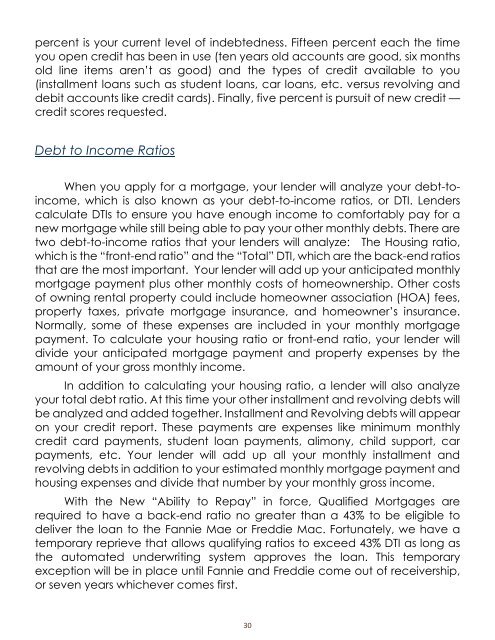Create successful ePaper yourself
Turn your PDF publications into a flip-book with our unique Google optimized e-Paper software.
percent is your current level of indebtedness. Fifteen percent each the time<br />
you open credit has been in use (ten years old accounts are good, six months<br />
old line items aren’t as good) and the types of credit available to you<br />
(installment loans such as student loans, car loans, etc. versus revolving and<br />
debit accounts like credit cards). Finally, five percent is pursuit of new credit —<br />
credit scores requested.<br />
Debt to Income Ratios<br />
When you apply for a mortgage, your lender will analyze your debt-toincome,<br />
which is also known as your debt-to-income ratios, or DTI. Lenders<br />
calculate DTIs to ensure you have enough income to comfortably pay for a<br />
new mortgage while still being able to pay your other monthly debts. There are<br />
two debt-to-income ratios that your lenders will analyze: The Housing ratio,<br />
which is the “front-end ratio” and the “Total” DTI, which are the back-end ratios<br />
that are the most important. Your lender will add up your anticipated monthly<br />
mortgage payment plus other monthly costs of homeownership. Other costs<br />
of owning rental property could include homeowner association (HOA) fees,<br />
property taxes, private mortgage insurance, and homeowner’s insurance.<br />
Normally, some of these expenses are included in your monthly mortgage<br />
payment. To calculate your housing ratio or front-end ratio, your lender will<br />
divide your anticipated mortgage payment and property expenses <strong>by</strong> the<br />
amount of your gross monthly income.<br />
In addition to calculating your housing ratio, a lender will also analyze<br />
your total debt ratio. At this time your other installment and revolving debts will<br />
be analyzed and added together. Installment and Revolving debts will appear<br />
on your credit report. These payments are expenses like minimum monthly<br />
credit card payments, student loan payments, alimony, child support, car<br />
payments, etc. Your lender will add up all your monthly installment and<br />
revolving debts in addition to your estimated monthly mortgage payment and<br />
housing expenses and divide that number <strong>by</strong> your monthly gross income.<br />
With the New “Ability to Repay” in force, Qualified Mortgages are<br />
required to have a back-end ratio no greater than a 43% to be eligible to<br />
deliver the loan to the Fannie Mae or Freddie Mac. Fortunately, we have a<br />
temporary reprieve that allows qualifying ratios to exceed 43% DTI as long as<br />
the automated underwriting system approves the loan. This temporary<br />
exception will be in place until Fannie and Freddie come out of receivership,<br />
or seven years whichever comes first.<br />
30


